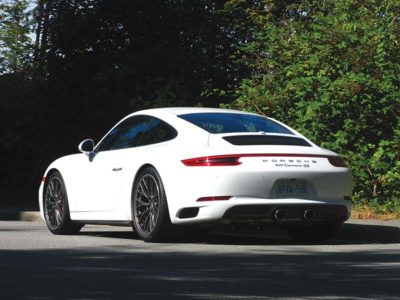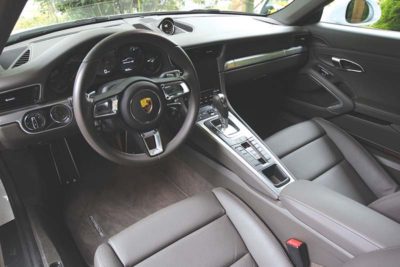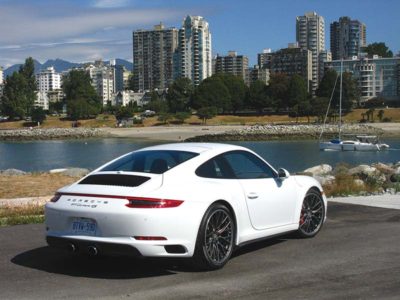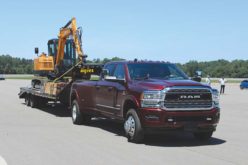
When is a turbocharged Porsche 911 not called a Porsche 911 Turbo? For four decades, the 911 Turbo has been the top-of-the-line for Porsche’s iconic car.
But what is this, then? A regular 911 Carrera with twin turbochargers? How can that be? Well, believe it – all 991.2 (second version of the latest generation) Carreras, in basic and “S” trim, are now turbocharged. The new engines, thankfully still with six cylinders, are smaller, 3.0 litres versus the normally aspirated 3.4 and 3.8 units from before, but generate more power and torque.
The Carrera 4S we drove has 420 hp (versus 400 before) and 368 lb-ft of torque (325 before). These are significant gains, but do they come with any compromise in the expected 911 driving experience? Not at all. Certainly, by the numbers, the increase in power and especially torque has made for an even quicker 911, with Porsche claiming sub-4 second times to 100 km/h, 11-second quarter miles at 120 mph, and a top end north of 180 mph, for what that is worth. The key change is that maximum torque, previously at 5,600 rpm, now comes in as low as 1,700 rpm, thanks to the turbos. In easy driving around town, or cruising up a hill on rural highways at 100 km/h, it is something to see the gear indicator say “7” and the engine being happy about it.
With turbos, one might expect some hesitation or lag at lower rpms, but there was none that we noticed. They are small and well-managed electronically with a new anti-lag system, and all you notice is an almost imperceptible low whistle sound that all turbos emit.
We were not surprised, or disappointed, to see that our tester had the 7-speed PDK twin-clutch manumatic transmission on board. We’ve come to really enjoy the quick shifting, up or down, of this unit, and the ease of driving in urban traffic. At least a full-manual box is still available for the true purists, but the PDK is quicker in all measurable acceleration, and even more so with the launch control that is part of the Sport Chrono package. If that is not enough, PDK delivers almost ten percent better fuel efficiency in the city, with equal highway efficiency. Add that to the estimated 12-percent improvement just from the new engine alone, and you get a reasonable 8.5L/100 km at 110 km/h.
The 911’s all-wheel drive system is really an on-demand one, primarily a rear-drive set-up that directs power to the front when traction is needed. Obviously, loose surfaces is one such time, but so is exiting a slower corner with heavy throttle. It is all transparent, of course, but in the end, the added weight is worth having great traction.

Primary among those, for significance and price ($7,780) is the Sport Package (as if the regular car is not-so-sporty) that includes the aforementioned Sport Chrono package, sport mirrors, sport steering wheel (with a new control wheel under the right thumb to select driving mode), and sport exhaust (with two modes, both with that marvellous raspy sound with wastegate pops and gurgles added in), and the most important feature for handling, Rear Axle Steering. At slow speeds, it makes the car turn in quicker, and at higher speeds, it increases stability. While we didn’t have a non-rear steer 911 to try for comparison, we can say that one so equipped handles on the proverbial rails. At every part of a turn, the 911 is composed, balanced and communicative, in a way that drivers of some other so-called performance cars just can’t imagine.
The other option, a bit more of a bargain at $1,020, is the PASM Sport Suspension, which lowers the car 20 mm (nearly an inch). Combine that with the gorgeous $2,710 20-inch RS Spyder (the prototype race car from several years ago) wheels, and you have just a perfect stance, very reminiscent of another famous Porsche race car, the 911 GT1 from Le Mans, 20 years ago. On the other hand, with the seat only a few inches off the ground, getting in and out of the car is not for those who aren’t limber. Nor does the lowered ride height help while negotiating the imperfections of urban roadways, such as speed bumps, driveways, etc. A raising system for the front suspension is available to help gain back some clearance, and we wish our tester had had it.

But the essence of the 911 remains the same. It is a reliable, all-weather everyday supercar, with a heritage that is not exceeded in the high-end market place. The Carrera 4S starts at $126K, and one equipped as ours was will set you back some $152K. For most people, that is a lot, but it is half or less what you will pay for an Italian or British exotic. On that level, and for those who know good value, it is a bargain.
Just don’t call it a Turbo.













